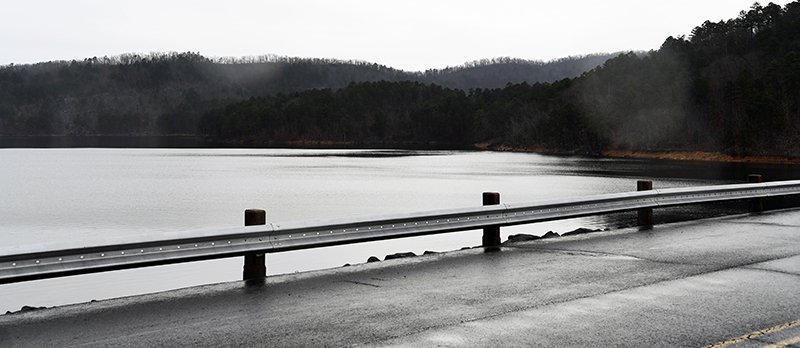Boring a tunnel 300 feet under Blakely Mountain would enable water from Lake Ouachita to gravity flow to a treatment plant off Amity Road, an engineer told the Hot Springs Board of Directors earlier this week.
Matt Dunn of Crist Engineers Inc., the Little Rock firm awarded a $1 million contract for preliminary design and engineering work on the Lake Ouachita project, said the tunnel concept came into focus after a site for an intake structure was identified in a small cove east of the main channel. A 48- to 60-inch diameter tunnel 2,300 feet long would connect the intake to a 17-mile-long raw waterline feeding a 15 million-gallon a day treatment plant the city plans on building at Little Mazarn Road.
The intake, tunnel, raw waterline, plant and finished waterlines are the primary elements of a roughly $100 million project to bring online the 23 million-gallon average day allocation the city secured from the U.S. Army Corps of Engineers in May 2017.
Financed by the water rate increase the board approved in late 2017, the project is in the preliminary design phase. The $20 million bond issue the city floated last year includes $5 million to get the project started. Dunn told the board part of that debt will pay for a geotechnical investigation into the feasibility of a tunnel.
It will also purchase 33 acres the board authorized the city to acquire for the plant site in October. The $500,000 transaction is expected to close soon, the city said earlier this week.
Dunn said boring data the Corps collected prior to the construction of Blakely Mountain Dam in the 1950s indicates soil conditions are favorable for a tunnel.
"The data looks promising, but it all has to be confirmed through our own geotechnical investigations, which is expensive but required to build a tunnel like this," he told the board. "If we're successful with the tunnel design, we will be able to gravity flow from Lake Ouachita to the treatment plant down Amity Road.
"We think it will be a substantial amount of water. That's exciting. That doesn't come around every day in our business."
Gravity flow lowers pumping costs, which Dunn said would be substantial when calculated over the life of the water system. An intake site the city was considering west of the main channel near Echo Canyon Resort and Marina would have required water to be pumped over Blakely Mountain's 900-foot elevation, he said.
Crist said water pressure is sufficient to gravity feed from the tunnel when the lake is at normal elevation, but pumping would be needed if a drop in elevation accompanies a spike in demand.
Collecting core samples along the entire length of the proposed steel-encased tunnel alignment will reduce uncertainty contractors are inclined to price into their bids, Dunn said.
"They have to know how hard the rock is, how abrasive it is," he said. "We've got to go through a fairly exhaustive geotechnical investigation for this option of the intake design. Doing a horizontal core on our actual tunnel alignment is the best way to do it. It removes all doubt about what the rock conditions are along the entire alignment of the tunnel.
"That will pay dividends on bid day, because you've removed all the risk from the contract. The more you can do that the better the prices."
Dunn said the state Health Department approved the site east of the main channel, and that monthly samples taken since July at the surface and underwater elevations proposed for the intake screen have been of high quality.
Dunn said the screen would be about 40 feet below the surface, or at or below 535 feet above sea level. Water above that elevation is reserved for power generation. The city began amortizing its share of more than $12 million in water storage costs in 2017, paying $444,440 a year to the Corps for the cost of replacing power the water lost to municipal supply would have generated at the dam.
Hydroelectric power the government sells to utilities repays the public for its investment in the federal hydropower program, the Corps has said.
The tunnel concept also creates redundancy, the city has said, allowing a connection from the 17-mile-long raw waterline to the existing plant that treats water drawn from the upper Lake Hamilton intake. Locating the Lake Ouachita intake east of the main channel puts the raw waterline on the same side of the watershed as the Lake Hamilton plant, which could be fed from Lake Ouachita if Lake Hamilton were to drop below the intake.
An intake east of Lake Ouachita's main channel will require the raw waterline to be bored under Lake Hamilton, Dunn said, probably at the Highway 270 west bridge near Treasure Isle Road. That moves the line to the west side of the watershed, where it can reach the plant on Little Mazarn Road.
Dunn said surveying work on a preliminary alignment that could affect more than 200 property owners has begun, explaining that Arkansas Entergy Inc. has been asked if the route could parallel the easement it secured for a large electrical transmission line.
Crist has said locating a plant south of the city, almost 20 miles from its water source, will improve distribution system hydraulics and water quality for customers on the south and east ends of the system. The city's finished water currently comes from the Lake Hamilton plant on the northwest end of the system and a small plant on the north end that treats water from the city reservoir at Lake Ricks.
The Lake Ouachita project is expected to be completed by 2022.
Local on 01/12/2019
